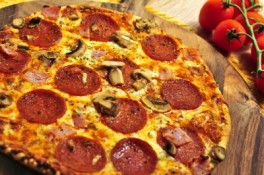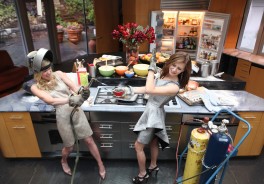
Pizza Stones: For Crust Just Like Nonna’s
We both really love pizza, and for an all-pizza episode of Anna & Kristina's Grocery Bag, we had 4 pizzas to make for our menu. Since the crust is such an important part of the experience, we had to find out which pizza stone gave the best crust.
The Basics
Pizza stones (or baking stones) are meant to simulate a wood-fired brick oven using just your home oven. They absorb and radiate intense, consistent heat in order to produce crisp, golden-brown crusts, calzones, and bread.
The pizza stone draws in and retains heat while distributing it evenly across the crust. It helps extract moisture from the dough, resulting in crispier crust.
Pizza stones are made from a variety of materials, including:
Unglazed terra cotta quarry tiles, hard-baked clayware, usually with a reddish hue. These can be purchased inexpensively from a home improvement store. The tiles should be at least 1/2-inch thick, preferably 1 inch thick. Be sure the tiles do not contain lead.
Ceramic stones come in various sizes and shapes, either glazed or unglazed natural clay. Unglazed stones are porous and extract moisture from dough to create crispness. Glazed stones clean up easier.
Natural soapstone pizza stones are made from a naturally-occurring hard rock called steatite, which must be cured before cooking usage.
Cast iron may come as regular or enameled, which are easier to clean up. Non-enamel cast iron must be seasoned regularly. Enamel cast iron pans may scratch, so be sure not to use metal utensils.
Most pizza stones are commonly 1/2″ thick, but thicker is better, up to 1″ thick is recommended.
When choosing a pizza stone material, determine whether the pizzas you’ll be making require extra high temperatures since some materials cannot withstand extremely high heat.
When it comes to size (diameter), buy the biggest one that will fit in your oven with about 1 inch on all size. Also consider how much space you have to store it easily in your cupboard. The biggest size will give you the most flexibility.
Keep in mind that pizza stones can also be used for making “artisan-style” bread.
Usage Tips
Stones of any material are sensitive to temperature, so be careful about putting cold water or cold dough on a hot stone.
Put your cold pizza stone in a cold oven and then heat it up.
Try to ensure your dough is room temperature before you put it on the hot pizza stone. If cold dough is placed on a hot stone, it may crack the stone.
Use a wooden paddle, called a peel, to put the dough on the stone. Be very careful since it will be extra hot and oven mitts may not be enough protection.
Remove the pizza from the oven with a metal spatula or tongs and slide it onto the peel or pizza pan.
Carefully follow the cleaning and maintenance tips provided for your pizza stone.
TEST CRITERIA
We invited Naples-trained pizza chef Salvatore Miele of BiBo Italian Restaurant to help us test 5 types of pizza stones against the authentic crust of PazzaRella wood-fired pizza crust. We tested:
- Unglazed quarry tile (terra cotta, home made): $8
:
Purchase at your local home improvement store
- Emile Henry Black Flame Pizza Stone (glazed clay, dishwasher safe): $49.95
:
- Lodge Pro Logic (cast iron): $79.99
:
- FibraMent (cement): $90
:
- Temperature Ware (soapstone): $98 USD
:
(Note: prices are approximate and in Canadian dollars)
Cooking Test
The PazzaRella dough was definitely delicious. Crisp yet with just the right amount of chewiness.
The inexpensive terra cotta tile made our crust too dry.
The Emile Henry glazed clay pizza stone made our dough come out very bread-like, with little crispness.
The FibraMent cement stone had a nice amount of chewiness.
The Lodge Logic tasted very close to our authentic PazzaRella crust.
The Temperature Ware (soapstone) crust came out super crisp, almost cracker-like.
OUR TOP PICK
It was a close choice between the FibraMent cement stone and the Lodge Pro Logic cast iron stone. We decided to go with the Lodge Pro Logic cast iron stone for our big cook day.
| Some products & services provided to this Anna & Kristina’s Grocery Bag episode courtesy of: |
|
 |
 |
 |
 |
 |
|










